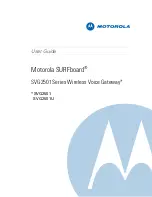
B
SVG2501 Series Wireless Voice Gateway • User Guide
iii
550885-001-a
•
If the battery leaks fluid and you touch it, immediately wash your hands. If the fluid gets into your eye, do not rub the
eye. Rinse with water and immediately seek medical care. Left untreated, the battery fluid could cause damage to
the eye.
•
Ensure that the battery does not receive any strong impacts, such as dropping or striking with a hard object.
•
At the end of battery life, the SVG2501 battery must be disposed of properly and may need to be recycled. Contact
your local recycling center for proper disposal methods.
•
Do not disassemble, modify, or attempt to repair the battery.
•
Before installation, the battery should not be subjected to temperatures below –10º C or above +60º C (14º F to 140º
F). After initial customer usage (initially charged above shipping charge state), the battery should not be subjected to
temperatures outside the operating temperature range:
Battery Pack External Exposure Operating Temperature Range:
•
Charging: 0.0° C to +45.0° C (0º F to 113º F)
•
Discharging: –10.0° C to +60.0° C (14º F to 140º F)
Important VoIP Service Information
Please contact your Internet Service Provider (ISP) and/or your local municipality for additional
information on making emergency calls using VoIP service in your area.
When using this VoIP device, you CANNOT make any calls, including an emergency call, and emergency
location services (where supported) WILL NOT be available, under the following circumstances:
•
Your broadband ISP connection goes down, is lost, or otherwise fails.
•
You lose electrical power.
•
You have changed the physical address of your VoIP device, and you did not update or otherwise
advise your VoIP service provider of this change.
•
There are delays in making your location information available in or through the local automatic
location information database.
Note
: Your service provider, not Motorola, is responsible for the provision of VoIP telephony services through this
equipment. Motorola shall not be liable for, and expressly disclaims, any direct or indirect liabilities, damages, losses,
claims, demands, actions, causes of action, risks, or harms arising from or related to the services provided through this
equipment.
FCC STATEMENTS
FCC Interference Statement
This equipment has been tested and found to comply with the limits for a Class B digital device, pursuant to part 15 of
the FCC Rules. These limits are designed to provide reasonable protection against harmful interference in a residential
environment. This equipment generates, uses, and can radiate radio frequency energy and, if not installed and used in
accordance with the instructions, may cause harmful interference to radio communications. However, there is no
guarantee that interference will not occur in a particular installation. If this equipment does cause harmful interference
to radio or television reception, which can be determined by turning the device off and on, the user is encouraged to try
to correct the interference by one or more of the following measures:
•
Reorient or relocate the receiving antenna.
•
Increase the separation between the device and receiver.
•
Connect the equipment into an outlet on a circuit different from that to which the receiver is connected.
•
Consult the dealer or an experienced radio/TV technician for help.








































